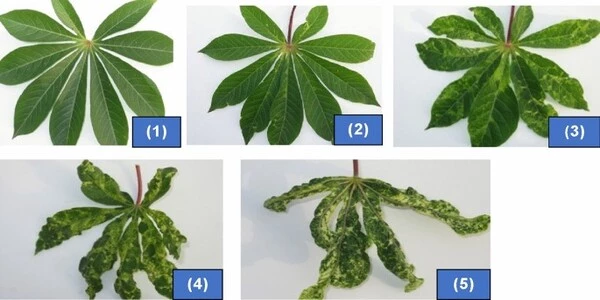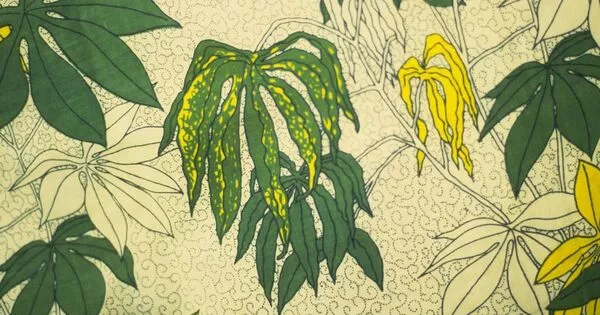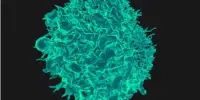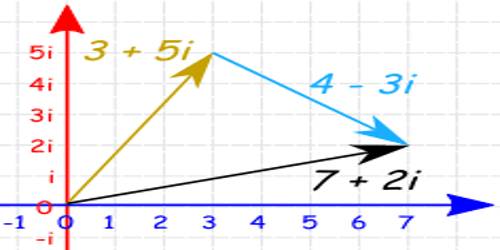Researchers have identified the gene responsible for resistance to the devastating cassava mosaic disease in certain cassava cultivars. This is a critical step in developing virus-resistant cassava varieties. Cassava mosaic disease (CMD) symptoms on cassava. When compared to a healthy plant, an infected plant exhibits severe stunting and leaf distortion (A) (B). CMD-affected plants’ leaves have misshapen and twisted leaflets with mosaic and mottling symptoms (C and D).
Cassava, also known as manioc, is a staple food and an important source of raw materials for nearly one billion people. It provides income to smallholder farmers, particularly in Africa. Cassava is a low-maintenance crop that grows in both wet and dry conditions.
However, many pests and diseases have an impact on cassava cultivation. The crop is frequently harmed by cassava mosaic disease (CMD). CMD is caused by DNA geminiviruses that are spread to plants by sap-sucking whiteflies (Bemisia tabaci) and has the potential to destroy entire fields and decimate yields.
Cassava mosaic disease is a major problem in Africa and India. The virus, however, is now spreading through cassava fields in Southeast Asia. CMD-resistant cassava cultivars are desperately needed by growers and farmers.
We don’t know how the resistance mechanism works yet. This is something that needs to be looked into in future studies. These changes could affect the way the DNA polymerase works, causing it to fail correcting errors in the replicating viral DNA; these errors ultimately stop the virus from replicating and spreading in the plant.
Wilhelm Gruissem
Research consortium tracks down resistance gene
A discovery by an international research team led by Wilhelm Gruissem, Professor of Plant Biotechnology at ETH Zurich, may be on the way. The team used elaborate and time-consuming genome analyses on several resistant and susceptible West African cassava cultivars to identify the gene responsible for cassava mosaic virus resistance.
Farmers in West Africa discovered the resistance after noticing that while the majority of their cassava plants in the field died as a result of the viral infection, a few plants survived. This piqued the interest of researchers, who set about determining the source of the resistance.
The team led by Wilhelm Gruissem found that the resistance is caused by a single gene that is the blueprint for a DNA polymerase – an enzyme responsible for replicating DNA within a cell – in their study, which was recently published in Nature Communications. The DNA polymerase, on the other hand, not only replicates DNA but also “proofreads” it to correct errors in the sequence of DNA building blocks that may occur during replication. And it is precisely this enzyme that geminiviruses require in order to replicate their own DNA and thus reproduce.

Is the DNA polymerase no working correctly?
Cassava has two copies of each gene because it has a double set of chromosomes. When one copy of the DNA polymerase gene is mutated, the viruses are unable to multiply and the infection is terminated. However, in plants that are susceptible to the disease, both copies of the DNA polymerase gene lack the mutation that causes CMD resistance.
“We don’t know how the resistance mechanism works yet,” Gruissem says. “This is something that needs to be looked into in future studies.” However, he believes the mutations affect an area of the enzyme that is responsible for error correction during DNA replication. These changes could affect the way the DNA polymerase works, causing it to fail correcting errors in the replicating viral DNA; these errors ultimately stop the virus from replicating and spreading in the plant.
Targeted virus resistant breeding with genome editing
The researchers are helping to improve food security in tropical and subtropical regions by identifying the gene responsible for what is known as CMD2 resistance. The gene they discovered is now used as a genetic marker by breeders to determine whether or not the resistance is present in their plants.
Exporting stems from virus-resistant cassava plants from West Africa to Asia for field propagation is not feasible for economic and agronomic reasons. That means Asian breeders will have to devise a new method of introducing resistance into their plants. “A modern CRISPR-Cas technology could be used to precisely edit the DNA polymerase gene and activate disease resistance,” Gruissem says.
The research project involved researchers from ETH Zurich as well as from the Donald Danforth Plant Science Center in St. Louis, the University of California Los Angeles and the National Crops Resources Research Institute in Uganda. A substantial portion of the research funding was provided by the Bill & Melinda Gates Foundation.
















